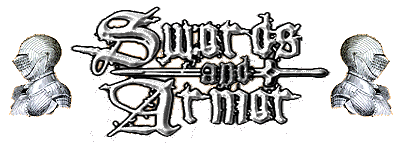
Sword of William Wallace - Replica

Who was William Wallace ? Have you ever seen the movie "Braveheart" and been completely enthralled with William Wallace of Scottish fame as portrayed by Mel Gibson brandishing his Claymore sword? Wallace was and still is a very fascinating man and a memorable piece of Scotland's history. William Wallace was born somewhere between the years of 1270-1276 based on available research, however, the most accurate year is likely 1272. His father was Sir William Wallace, and he was the second of three sons. Records of Wallace's life are patchy and often inaccurate, partly because he inspired such fear in the minds of the English writers at that time that they diminished him, his achievements, and his motives.
While a teenage William received his education in the church, his father and older brother were on the run from the English. Combined with an education in the principals of liberty and the right of the individual, William's grudge against the English became a crusade when his sweetheart was killed by an English sheriff. William retaliated, killing the sheriff with his sword, and thus became an outlaw in his own country. From then on, Wallace was the leader of the Scottish fight for independence. Wallace was fearlessly single-minded in his aim to free Scotland from English domination. Wallace had extraordinary personal strength, outstanding weapon skills, undaunted courage, enterprising spirit, and dexterity. Those attributes coupled with his ardent attachment to his native country and his inextinguishable hatred of his oppressors, rendered him well fitted to be the leader of a band of patriots burning to avenge the wrongs of their suffering fatherland.
swords homepage Scottish replica weapons
highlands broadsword sword index
By 1297, Wallace controlled much of Scotland. His battles were the stuff of legends. On September 11, 1297, Wallace's army met the English at Stirling Bridge. By this time, he had an army of about 5,000 men, with only 100 knights. The English had 50,000 foot soldiers, 4,000 archers, and 1,000 heavy cavalry knights. When the English army came, he waited on a hill while half of the English army crossed the bridge. At a signal from him, some of his men hiding below the bridge knocked the supports out so the bridge fell, killing many that were on it at the time, and dividing the enemy force. Other English commanders just watched in horror as their army was massacred before them. Panic then took over and they ran for it, not stopping until they reached the English border. Although outnumbered, his army was able to defeat the English army at Stirling bridge, using strategy and intimidation. The next year, he was knighted and elected the Guardian of Scotland.
The Scottish victory at Stirling Bridge resulted in the English invading Scotland with a very large army. The Scots were defeated, and over the next 6 years, the English beat the resistance down until, by 1304, Scotland was again under English domination. He kept up the fight and traveled extensively in Europe trying to get support from King Haakon of Norway, the Pope, and the French. For 7 years, he fought desperately for Scotland's freedom until he was captured on August 3 1305 near Glasgow. He was then taken to London and tried and convicted of treason. Upon being found guilty, he was condemned to death to be carried out that day in the most inhumane and brutal way possible. He was dragged through the streets of London to the gallows where the hanging was supposed to take place. After being hanged for a short time, he was taken down, still breathing, so as to continue the suffering. His heart, liver, lungs, and entrails were removed and thrown into a fire. Then, he was decapitated and his head stuck on a pole on London Bridge. The body was then cut into four pieces and scattered throughout the country.
There is a 21.5 foot tall statue erected in the Dryburgh that honors one of Scotland's favorite sons. This was placed there on September 22, 1814, 509 years after his death. People still continue to visit this statue in honor of Scotland's hero.
fantasy weapons helmets armor wearable armor
shields SCA Civil War History of the Knights
copyright © 2001-2014 swordsandarmor.com
. All Rights Reserved.
privacy policy